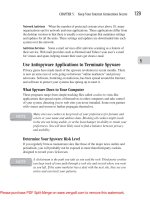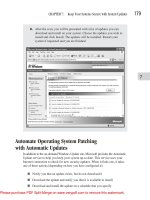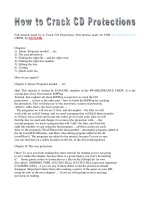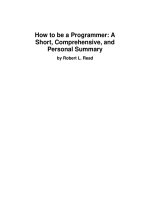Resource: How to Add Users to CSACS-NT ppt
Bạn đang xem bản rút gọn của tài liệu. Xem và tải ngay bản đầy đủ của tài liệu tại đây (152.58 KB, 4 trang )
Resource: How to Add Users to CSACS-NT
Figure [1] Users setup screen on Windows version of Cisco Secure ACS
The following process illustrates how to add users to the
CSACS. An explanation of each of the windows where that
account can be edited is then provided.
Step 1 Click User Setup from the navigation bar. The Select
window opens.
Step 2 Enter a name in the User field.
Note The username can contain up to 32 characters. Names cannot
contain the following special characters: #, ?, ", *, >, and <. Leading and
trailing spaces are not allowed.
Step 3 Click Add/Edit. The Edit window opens. The username
being added or edited appears at the top of the window.
The Edit window contains the following sections:
■ Account Disabled
■ Supplementary User Info
■ User Setup
■ Account Disable
Account Disabled
If you need to disable an account, select the Account Disabled
check box in the Account Disabled section to deny access for this
user.
Note You must click Submit to have this action take effect.
Supplementary User Info
In this section, you can enter supplemental information to appear
in each user profile. The fields shown below are available by
default. However, additional fields may be inserted by clicking
Interface Configuration in the navigation bar and then click User
Data Configuration (configuring supplemental information is
optional):
■ Real Name—If the username is not the real name of the
user, enter the real name here.
■ Description—Enter a detailed description of the user.
User Setup
In the User Setup group box, you can edit or enter the following
information for the user as applicable:
■ Password Authentication—From the drop-down menu,
choose a database to use for username and password
authentication. Select the Windows NT user database or the
Cisco Secure database. The Windows NT option
authenticates a user with an existing account in the
Windows NT user database located on the same machine as
the CSACS server. The Cisco Secure database option
authenticates a user from the local CSACS database. If you
select this database, enter and confirm the Password
Authentication Protocol (PAP) password to be used. The
separate CHAP/MS-CHAP/ARAP option is not used with
the PIX Security Appliance.
Note: The Password and Confirm Password fields are required for all
authentication methods except for all third-party user databases.
■ Group to which the user is assigned—From the Group to
which the user is assigned drop-down menu, choose the
group to which to assign the user. The user inherits the
attributes and operations assigned to the group. By default,
users are assigned to the Default Group. Users who
authenticate with the Unknown User method who are not
found in an existing group are also assigned to the Default
Group.
■ Callback—This is not used with the PIX Security
Appliance.
■ Client IP Address Assignment—This is not used with the
PIX Security Appliance.
Account Disable
The Account Disable group box can be used to define the
circumstances under which the user account will become disabled.
Note: This is not to be confused with account expiration due to password
aging. Password aging is defined for groups only, not for individual users.
■ Never radio button—Select to keep the user’s account
always enabled. This is the default.
■ Disable account if radio button—Select to disable the
account under the circumstances you specify in the
following fields:
– Date exceeds—From the drop-down menu, choose the
month, date, and year on which to disable the account.
The default is 30 days after the user is added.
– Failed attempts exceed—Select the check box and enter
the number of consecutive unsuccessful login attempts
to allow before disabling the account. The default is 5.
– Failed attempts since last successful login—This
counter shows the number of unsuccessful login
attempts since the last time this user logged in
successfully.
■ Reset current failed attempts count on submit—If an
account is disabled because the failed attempts count has
been exceeded, select this check box and click Submit to
reset the failed attempts counter to 0 and reinstate the
account.
If you are using the Windows NT user database, this expiration
information is in addition to the information in the Windows NT
user account. Changes here do not alter settings configured in
Windows NT.
When you have finished configuring all user information, click
Submit.









